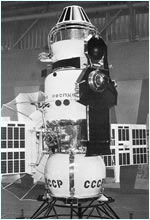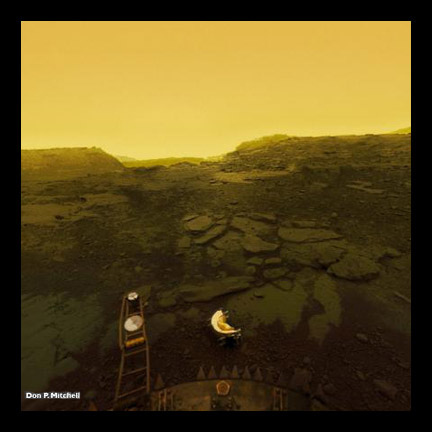The Soviet Union conducted an ambitious scientific program focused on studying Venus. They called their robotic spacecraft missions Venera and Vega. The launch technology for all these missions was the R-7, the Soviet’s most reliable rocket. There were many technology challenges to overcome. The Soviets needed to develop spacecraft capable of withstanding not only the highly acidic atmosphere but also the intense heat and pressure on the planet’s surface. This meant building pressurized containers encased in passive thermal protection able to withstand 460 degrees Celsius (860 Fahrenheit). Cameras, telecommunications receivers and transmitters, surface sampling technology, robotic arms, drill motors and sensors, all needed to be tempered to survive in both the heat and intense pressure. Unfortunately at best these landers and balloon instrumentation could not use solar power to extend operational life and were limited at most during later missions to 60-hours of battery power.
Many early Venera launches either failed to achieve orbit, got stuck in Earth orbit, or in attempting a flyby suffered from spacecraft systems failures. Even in February 1966 when Venera-2 successfully achieved its rendezvous with Venus its instrumentation and on board television camera system failed. Venera-3, also launched in November 1965, however, did achieve its goal of colliding with the surface of Venus in March 1966, the first spacecraft to impact another planet. But like its predecessor the scientific instrumentation onboard failed including the radio communication system and all data was lost.
The Soviets kept trying. In June 1967 Venera-4 launched with a goal to study the atmosphere of Venus. The spacecraft came in two parts, a main body and separate lander. The main spacecraft instrumentation included a magnetometer, cosmic ray detector, charged particle traps, and a hydrogen and oxygen sampler. The lander instrumentation included two thermometers, a barometer, a radio altimeter, atmospheric density gauge, 11 gas analyzers and two radio transmitters. Using a parachute system to brake its descent, the lander transmitted data until it reached 25 kilometers (16 miles) above the planet surface. The data transmitted back to Earth indicated atmospheric temperatures of 262 degrees Celsius (504 Fahrenheit) at an altitude of 26 kilometers with atmospheric pressure 22 times that of Earth at sea level. Atmospheric composition was 90-93% CO2, 7% nitrogen and traces of oxygen and water vapour.

Venera-5 and Venera-6, both launched in 1969, were also combination spacecraft and lander and both reached the planet surface transmitting data for over 50 minutes each before atmospheric heat, pressure and loss of power led to total system failures.
Through the 1970s and 1980s a series of Venera spacecraft including orbiters and landers slowly unravelled the mysteries of Venus. Beginning with Venera-7 in 1970, the Soviets accomplished the first soft landing on Venus transmitting data for 35 minutes during descent and for 23 minutes on the surface before going silent. Venera-8 accomplished the same feat in 1972 this time transmitting from the surface for 50 minutes. In 1975 Venera-9 and 10 successfully touched down on Venus transmitting black and white images of the surface back to Earth. Venera-13 and 14 landers in 1981 successfully transmitted colour images of the surface for the first time. These missions were followed by two radar-mapping orbiters in 1983, Venera-15 and 16.
The last Soviet missions to Venus were multitask missions designed to study the planet and then move on to a rendezvous with Halley’s Comet. The two spacecraft, called Vega-1 and 2 carried out their missions in 1984 by placing landers once again on the planet’s surface. Both also deployed balloons which stayed aloft in the atmosphere, one transmitting data for 47 hours, covering 9,000 kilometers (5,000 miles) before bursting.
The science learned from Venera and Vega gave us a good picture of the planet’s atmosphere and the landers provided us with data on the lowland properties of the planet’s surface. No landings occurred in highland areas and to this day we have only remote sensing data analysis of these very large planetary features. But the samples retrieved and examined by Venera and Vega showed that Venus had a rocky surface covered with massive volcanic outflows and that much of the sampled material was a form of basalt containing traces of uranium, thorium and potassium.

The Venera and Vega spacecraft and landers were remarkable feats of engineering for the 1970s and 80s and clearly demonstrate the quality of Soviet technology at the time. But with their scientific revelations showing Venus to be far from hospitable other Solar System objects soon became far more appealing targets. One of those was Mars, our next closest planetary neighbour and one where the American program from the 1970s onward delivered spectacular results. In some respects in choosing to concentrate on exploring Venus, the Soviets picked the wrong horse. Nonetheless, their contribution to space technology in overcoming its hostile environment represented a space exploration milestone.








